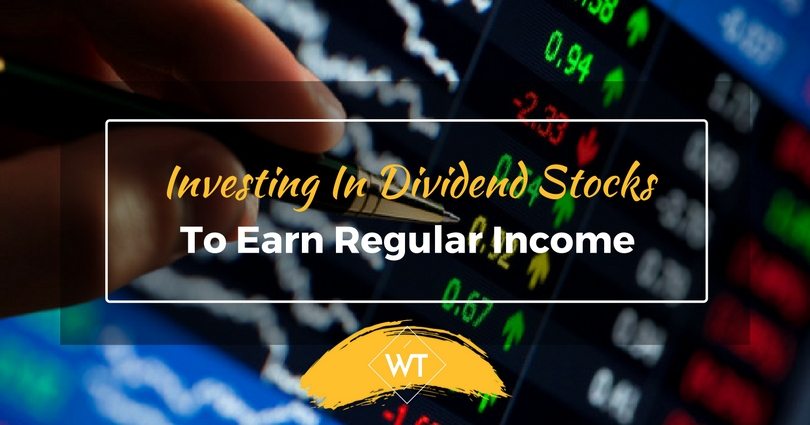Investing in Dividend Stocks to earn Regular Income

Most people save their surplus earnings in order to make sure they have some reserves ready for emergencies or unanticipated expenses. In addition to this the remaining funds are invested so that they can grow and serve future needs.
The investment can be made in various avenues such as bonds, stocks, real estate, etc, each having its own risk-return characteristics and features. Investments have the capability of providing returns in the form of income or capital appreciation.
Dividend stocks can generate income on a regular basis assuming you invest in stocks that are known to provide regular and consistent amount of dividend.
Can one really earn regular incomes by simple investing in stocks?
The answer is obviously not a simple “Yes” or “No” because of the risks and uncertainties involved. Of course you can earn a regular income provided you have a sizable portfolio of dividend stocks. But given that stocks are risky you may not only lose your income, but also have the risk of losing you capital.
Like any trade or profession it takes a lot of time, money (investment), energy and understanding of business/industry cycles and trends to become adept at investing. However, people who have a sizable corpus (i.e. high net worth individuals) may be able to simple hire someone to manage a portfolio and generate regular income with dividend stocks.
But for smaller investors this is a gradual process and requires patience and discipline before the portfolio starts generating sizable income.
There are two challenges:
– one is “earning regular income”
– the other is to “generate sizable income”.
If both these challenges are addressed one can claim to have achieved significant success in stock investing.
Understanding Dividend Yield
Before getting into dividend stocks, let us understand dividend yield. Dividend yield is one of the key indicators of the yield or return you get from a stock in the form of dividend. It is calculated by dividing the Dividend per share by its Market Price.
For instance assume a company EFGH Ltd. (one of the dividend stocks) declares a 100% dividend on its stock with face value of Rs.10. Lets say the stock is trading at Rs.400. What will be the dividend yield? Its about 2.5% (i.e. 10/400 X 100).
For a normal person a 100% dividend seems like a bonanza, but in reality its just peanuts because compared to the investment Rs.400 the dividend is only Rs.10.
In the recent past the regulator SEBI (Securities Exchange Board of India) also required all companies to report the dividend figure per share. This will give investors a true view of dividend per share vs. market price per share.
Taking the same example forward, suppose in 2012 let us assume EFGH Ltd. (one of the dividend stocks) maintains the same dividend policy and declares a dividend of Rs.10 per share. In this case if stock price falls to Rs.300 due to prevailing market conditions, what will be your yield if you purchase the stock at Rs.300 and get the same dividend?
Since the price paid (investment is less) it is a favorable investment keeping all other factors constant. So dividend yield will be 3.33% (10/300 X 100). Generally speaking, investing in dividend stocks will provide some regular income. But how attractive the dividend will be is a matter of debate which we will discuss now.
Truth about Dividends
A few points that one should know about dividends are below. These may sound too basic or elementary but most people lose sight of the basics when they get carried away by market movements.
1. Dividends are based on face value.
Once dividend is declared as x% of face value, it does not matter if stock price goes up or down. The dividend amount is fixed and constant. However, dividend yield will change depending on the price at which you bought. (See example above for more clarity)
2. Dividend yield will generally be less.
In most cases not exceeding 5%, barring a few exceptions and cases special pay outs (like a company completing 100 years or some special milestone, etc.)
The yield will not be even as good as bank fixed deposits, but it is tax free in the hands of investors today. Unless there is a change in tax regulation this is going to be a plus point.
3. Share Splits & Bonus Shares
Although a split is just an adjustment to the number of shares and does not affect your stock value, it can be positive because more investors would participate and the divided (if declared) could turn out to be little higher. Similar issue of additional bonus shares can also increase your future dividends.
4. Dividend Declaration
Dividend declaration is at the discretion of the board of directors, and also subject to profitability of the company. So even if the company announces good results the company may not declare dividend.
Unlike interest on fixed deposits which is assured, the dividend payout from stocks (even well known divided stocks) is not guaranteed.
Capital Appreciation
Stocks are known to appreciate in value over time. Capital appreciation happens when the company performs well and generates more earnings and assets for the stakeholders. Capital appreciation can be seen when share prices appreciate after good results or positive news from the company.
Further, the company may also declare bonus shares, which means you get additional shares free of cost as a bonus or incentive. The profit or loss due to capital appreciation is reflected in the current stock price compared to your acquisition price.
If you bought a stock at Rs.250 last year, which currently trades at Rs.275 your capital appreciation is roughly 10% (25 over 250) when compared to the acquisition price.
How to earn regular income out of dividend stocks?
This is possible if you have a strictly defined process and invest according to the same. Here I’m making an assumption that you have some basic knowledge about stocks, companies and economic trends.
If not please try to educate yourself atleast to a basic level so that you can take informed decisions and not be at the mercy/influence of your broker, friend or others. The key steps involved can be summarized as below:-
Step 1: Stock Selection
To select the right stocks you need to do a thorough analysis of your risk appetite and also study various stocks, industries and economic conditions.
Since there are 1000’s of stocks and dozens of industries, for starters and those who cannot devote time I suggest picking up good index stocks which have strong brand names, history and solid reputation.
Step 2: Implementing or Building your portfolio
Rome was not built in a day, and same goes with your portfolio. We focus on the stock portfolio here, but you also need to plan your overall portfolio (fixed income, real estate, gold, etc) as well.
The best way to start is to start buying the fundamentally strong stocks in small quantities and accumulating overtime. You can start anywhere, but add more whenever there is a dip or decline so that your overall cost of acquisition remains moderate.
Step 3: Portfolio Maintenance
This involves identifying performers, and laggards. Laggards can be sold or disposed before they become worthless. The other mediocre ones have to be monitored proactively so that you can take action before they turn laggards. Try to book profits (partially) in the following cases:-
- If you hold the investment for more than one year. As per current tax laws there are no long term capital gains tax on stocks (i.e. those held for over a year). In future this may change, so keep yourself updated on tax regulations or consult a tax advisor or chartered accountant.
- When you see that there is a sudden spike of more than 25% or so. However, some investors try to sell all their holdings which is a mistake. By selling out fully one loses out on the future earning potential – both dividends and capital appreciation.
Conclusion
All said and done, companies which pay regular dividends are a good bet because they can afford to do so given the strong business performance.
Spreading investments across 7-10 stocks (dividend stocks) will help you to spread your dividends across different periods of the year. Keeping track of dividend payouts can help you choose stocks that are consistent in declaring dividends.
For instance FMCG companies in general have a regular dividend track record. What if the company does not pay dividend? Not an issue, provided the company invests it back in to the business and generates good return you will get better capital appreciation.
Companies which needs funds may not generously declare dividend, where as companies that have good cash reserves and have a strong cash flow management system would be able to provide consistent dividends over time. If the free cash flow of a company is huge then the chances of dividend declaration is high.
To conclude, you must bear in mind the performance of the company as a whole and dividend is just one of the factors. Looking at one angle would be misleading like the case of six blind men touching various parts of an elephant.
Although dividends can tell you some part of the story, a holistic observation would give you the true and fair picture about a company’s financial performance.









Leave a Reply